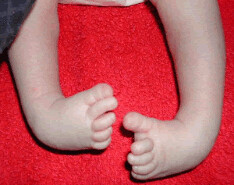Congenital talipes equinovarus ( CTEV )

DEFINITION
Congenital talipes equinovarus is most common Congenital foot disorder.
– Males are commonly affected then females.
– Talipes , Talus – ankle , PES – foot, causes patient to walk on ankle.
– Club foot : club like appearance.
• Types
(1) Osseus : Club foot associated with absence of tibia.
(2) Muscular : Arthrogryposis multiplex congenital or multiple congential contracture.
(3) Neuropathic : Due to spina bifida
(4) Idiopathic : No apparent cause.
• Etiology
✓ Primary club foot :
(A) mechanical theory
(B) ischemic theory
(C) Genetic theory
✓ Secondary clubfoot : paralytic disorders
• Pathoanatomy
✓ Bones : bones of foot are smaller than normal bones
✓ joint : equinus deformity, cavus deformity , inversion deformity, adduction deformy.
✓ muscle and tendons : muscles are underdeveloped and muscle – tendon unit is contracted.
✓ ligaments : shortened.
• Examination :
(1) Dorsiflexion test
– Normally the foot of a newborn child can be Dorsiflexed until the dorsum touches the anterior aspect of shin of the tibia.
– In case of CTEV dorsum of foot unable to touch shin of tibia.
(2) Plumb line test
(3)Scratch test
(4) Foot is in equinus , varus, and adduction
(5) Heel is small in size
(6) deep skin crease
(7) Bony prominences felt on lateral side of foot.
•Method of Maintainance of correction
(1) CTEV splints

– These are splints made of plastic, moulded in such a way that when tied with straps, it keeps the foot in corrected position .
(2) Dennis – Brown splint

– This is a splint to hold the foot in corrected position.
– It is used throughout the day before the child starts walking.
– Once he starts walking, Dennis brown splints can be used at night and CTEV shoes during day time.
(3) CTEV shoes
– These are modified shoes, used once child start walking .
• PT management
– When reported early , passive manipulation can be done.
– Immobilization is done by strapping or by POP cast .
• Manipulation
– 3 components of the deformity
✓ Pes cavus
✓ Adduction and inversion of forefoot and heel
✓ Plantar flexion of the ankle.
– Graded manipulation by passive movements is done in opposite direction of the deformity.
– Pes cavus can be corrected by strectching contracted soft tissues of foot until the correction is achieved.
– Addiction deformity can be corrected by keeping the thumb of both hands over talus and distal hand will abduct and Evert the foot, turning sole downwards and outwards ( eversion and Dorsiflexion )
– Plantar flexion can be achieved by raising the foot to Dorsiflexion.
– Maintainance of correction is important
– mother should be educated to identify if any distortion is occurs.
– Immobilization can be done by a adhesive strapping for mild cases.
– If no correction is achieved then ,
(1) Serial POP cast
(2) DB splints
(3) CTEV splint
– With plaster cast only toe movements and the movements to hip and knee can be encouraged by tickling or just holding child high.
– In surgical cases, if children are of walking age, gradual walking with walkers can be given
– Maintenance of correction of deformity after removal of cast is important and it also helps in preventing recurrence.
– Night splints maintains the foot in overcorrected position and prevent recurrence.
– Active movements
– Ambulatory training : For free walking , correct BK orthosis should be given so that the foot is maintained in corrected position.
– The child should be seen at least once a week , then every month and also at later stages.
– The treatment depends upon how effectively the mother is taught the home care programe.
